Pediatric Nursing Practices and Perspectives
VerifiedAdded on 2020/04/07
|9
|3015
|101
AI Summary
This assignment delves into the multifaceted realm of pediatric nursing by analyzing various scholarly articles. Key themes explored include children's theories of mind, pain perception from different viewpoints (child, parent, nurse), the impact of hospitalization on families, responsiveness in child care settings, and nurses' emotional experiences in paediatric care. The assignment encourages critical evaluation of research findings and their implications for nursing practice.
Contribute Materials
Your contribution can guide someone’s learning journey. Share your
documents today.
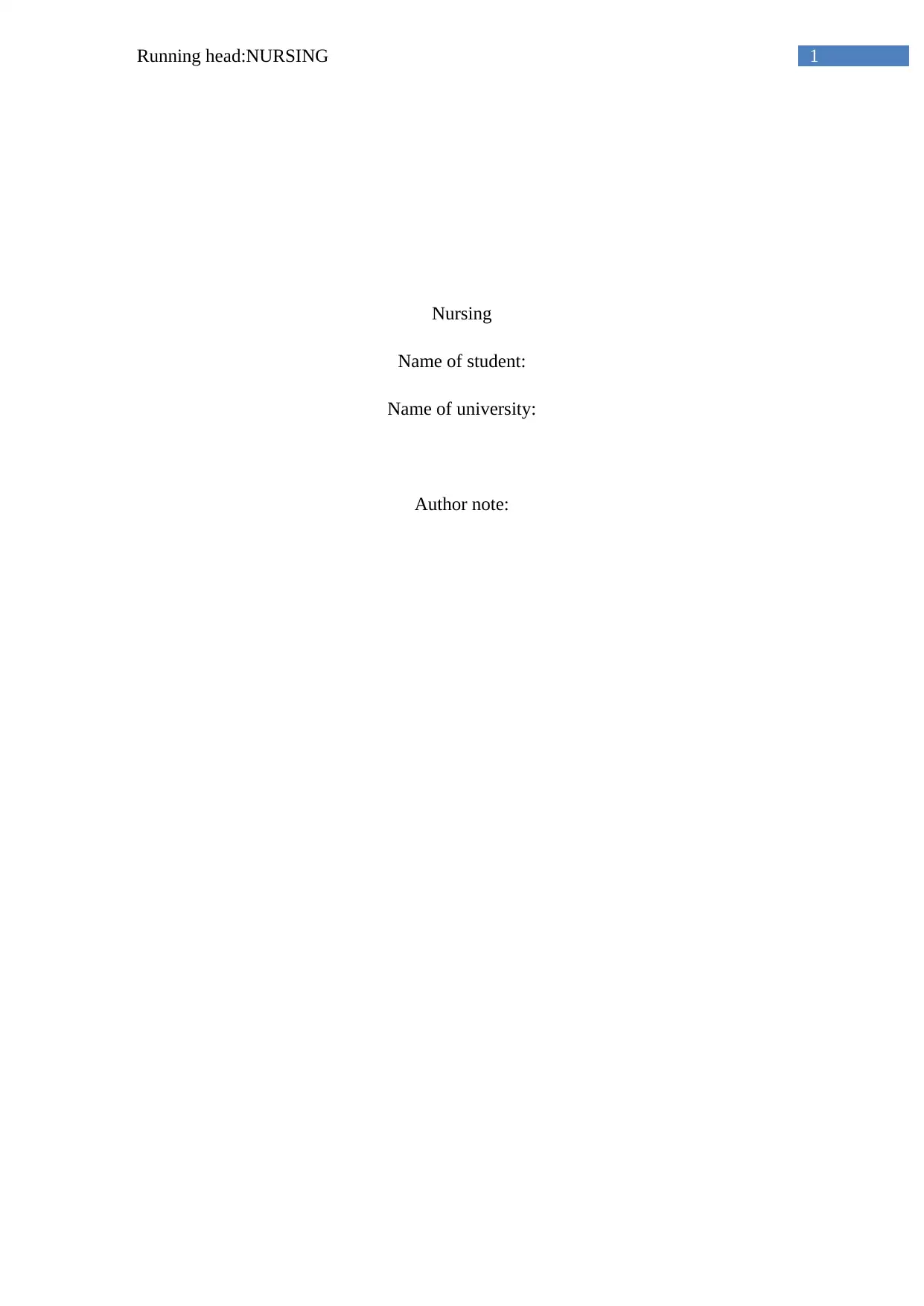
1Running head:NURSING
Nursing
Name of student:
Name of university:
Author note:
Nursing
Name of student:
Name of university:
Author note:
Secure Best Marks with AI Grader
Need help grading? Try our AI Grader for instant feedback on your assignments.
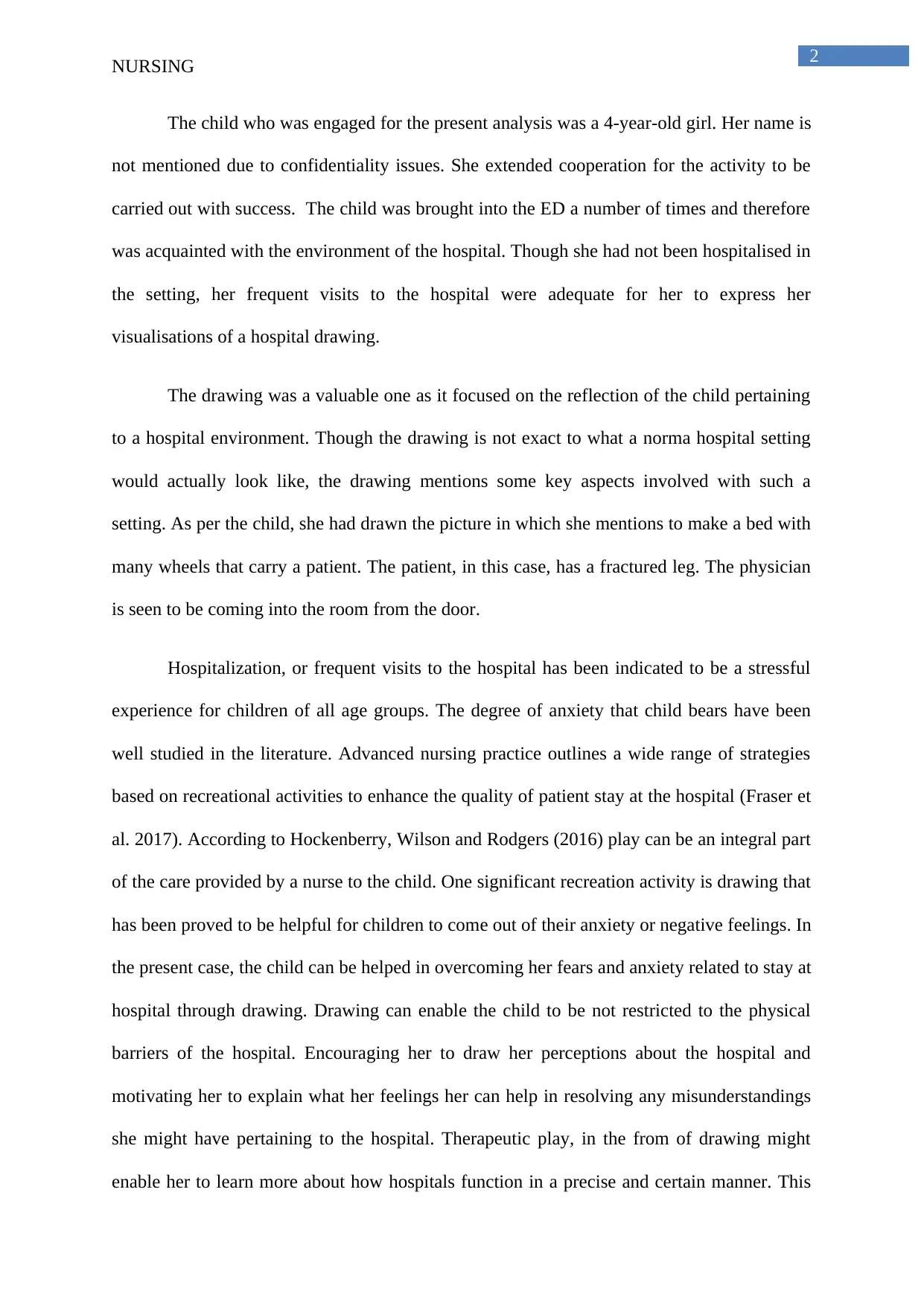
2
NURSING
The child who was engaged for the present analysis was a 4-year-old girl. Her name is
not mentioned due to confidentiality issues. She extended cooperation for the activity to be
carried out with success. The child was brought into the ED a number of times and therefore
was acquainted with the environment of the hospital. Though she had not been hospitalised in
the setting, her frequent visits to the hospital were adequate for her to express her
visualisations of a hospital drawing.
The drawing was a valuable one as it focused on the reflection of the child pertaining
to a hospital environment. Though the drawing is not exact to what a norma hospital setting
would actually look like, the drawing mentions some key aspects involved with such a
setting. As per the child, she had drawn the picture in which she mentions to make a bed with
many wheels that carry a patient. The patient, in this case, has a fractured leg. The physician
is seen to be coming into the room from the door.
Hospitalization, or frequent visits to the hospital has been indicated to be a stressful
experience for children of all age groups. The degree of anxiety that child bears have been
well studied in the literature. Advanced nursing practice outlines a wide range of strategies
based on recreational activities to enhance the quality of patient stay at the hospital (Fraser et
al. 2017). According to Hockenberry, Wilson and Rodgers (2016) play can be an integral part
of the care provided by a nurse to the child. One significant recreation activity is drawing that
has been proved to be helpful for children to come out of their anxiety or negative feelings. In
the present case, the child can be helped in overcoming her fears and anxiety related to stay at
hospital through drawing. Drawing can enable the child to be not restricted to the physical
barriers of the hospital. Encouraging her to draw her perceptions about the hospital and
motivating her to explain what her feelings her can help in resolving any misunderstandings
she might have pertaining to the hospital. Therapeutic play, in the from of drawing might
enable her to learn more about how hospitals function in a precise and certain manner. This
NURSING
The child who was engaged for the present analysis was a 4-year-old girl. Her name is
not mentioned due to confidentiality issues. She extended cooperation for the activity to be
carried out with success. The child was brought into the ED a number of times and therefore
was acquainted with the environment of the hospital. Though she had not been hospitalised in
the setting, her frequent visits to the hospital were adequate for her to express her
visualisations of a hospital drawing.
The drawing was a valuable one as it focused on the reflection of the child pertaining
to a hospital environment. Though the drawing is not exact to what a norma hospital setting
would actually look like, the drawing mentions some key aspects involved with such a
setting. As per the child, she had drawn the picture in which she mentions to make a bed with
many wheels that carry a patient. The patient, in this case, has a fractured leg. The physician
is seen to be coming into the room from the door.
Hospitalization, or frequent visits to the hospital has been indicated to be a stressful
experience for children of all age groups. The degree of anxiety that child bears have been
well studied in the literature. Advanced nursing practice outlines a wide range of strategies
based on recreational activities to enhance the quality of patient stay at the hospital (Fraser et
al. 2017). According to Hockenberry, Wilson and Rodgers (2016) play can be an integral part
of the care provided by a nurse to the child. One significant recreation activity is drawing that
has been proved to be helpful for children to come out of their anxiety or negative feelings. In
the present case, the child can be helped in overcoming her fears and anxiety related to stay at
hospital through drawing. Drawing can enable the child to be not restricted to the physical
barriers of the hospital. Encouraging her to draw her perceptions about the hospital and
motivating her to explain what her feelings her can help in resolving any misunderstandings
she might have pertaining to the hospital. Therapeutic play, in the from of drawing might
enable her to learn more about how hospitals function in a precise and certain manner. This
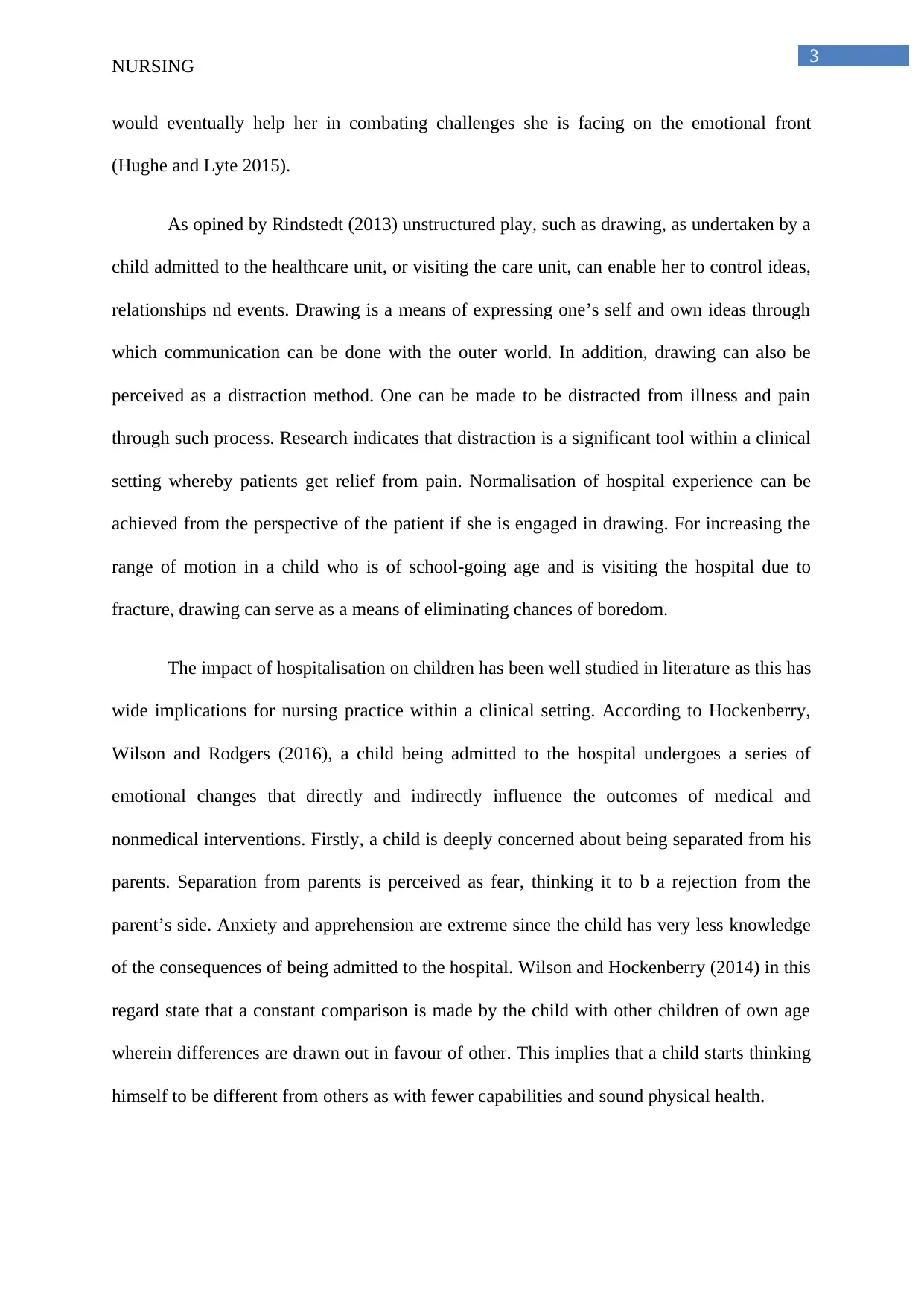
3
NURSING
would eventually help her in combating challenges she is facing on the emotional front
(Hughe and Lyte 2015).
As opined by Rindstedt (2013) unstructured play, such as drawing, as undertaken by a
child admitted to the healthcare unit, or visiting the care unit, can enable her to control ideas,
relationships nd events. Drawing is a means of expressing one’s self and own ideas through
which communication can be done with the outer world. In addition, drawing can also be
perceived as a distraction method. One can be made to be distracted from illness and pain
through such process. Research indicates that distraction is a significant tool within a clinical
setting whereby patients get relief from pain. Normalisation of hospital experience can be
achieved from the perspective of the patient if she is engaged in drawing. For increasing the
range of motion in a child who is of school-going age and is visiting the hospital due to
fracture, drawing can serve as a means of eliminating chances of boredom.
The impact of hospitalisation on children has been well studied in literature as this has
wide implications for nursing practice within a clinical setting. According to Hockenberry,
Wilson and Rodgers (2016), a child being admitted to the hospital undergoes a series of
emotional changes that directly and indirectly influence the outcomes of medical and
nonmedical interventions. Firstly, a child is deeply concerned about being separated from his
parents. Separation from parents is perceived as fear, thinking it to b a rejection from the
parent’s side. Anxiety and apprehension are extreme since the child has very less knowledge
of the consequences of being admitted to the hospital. Wilson and Hockenberry (2014) in this
regard state that a constant comparison is made by the child with other children of own age
wherein differences are drawn out in favour of other. This implies that a child starts thinking
himself to be different from others as with fewer capabilities and sound physical health.
NURSING
would eventually help her in combating challenges she is facing on the emotional front
(Hughe and Lyte 2015).
As opined by Rindstedt (2013) unstructured play, such as drawing, as undertaken by a
child admitted to the healthcare unit, or visiting the care unit, can enable her to control ideas,
relationships nd events. Drawing is a means of expressing one’s self and own ideas through
which communication can be done with the outer world. In addition, drawing can also be
perceived as a distraction method. One can be made to be distracted from illness and pain
through such process. Research indicates that distraction is a significant tool within a clinical
setting whereby patients get relief from pain. Normalisation of hospital experience can be
achieved from the perspective of the patient if she is engaged in drawing. For increasing the
range of motion in a child who is of school-going age and is visiting the hospital due to
fracture, drawing can serve as a means of eliminating chances of boredom.
The impact of hospitalisation on children has been well studied in literature as this has
wide implications for nursing practice within a clinical setting. According to Hockenberry,
Wilson and Rodgers (2016), a child being admitted to the hospital undergoes a series of
emotional changes that directly and indirectly influence the outcomes of medical and
nonmedical interventions. Firstly, a child is deeply concerned about being separated from his
parents. Separation from parents is perceived as fear, thinking it to b a rejection from the
parent’s side. Anxiety and apprehension are extreme since the child has very less knowledge
of the consequences of being admitted to the hospital. Wilson and Hockenberry (2014) in this
regard state that a constant comparison is made by the child with other children of own age
wherein differences are drawn out in favour of other. This implies that a child starts thinking
himself to be different from others as with fewer capabilities and sound physical health.
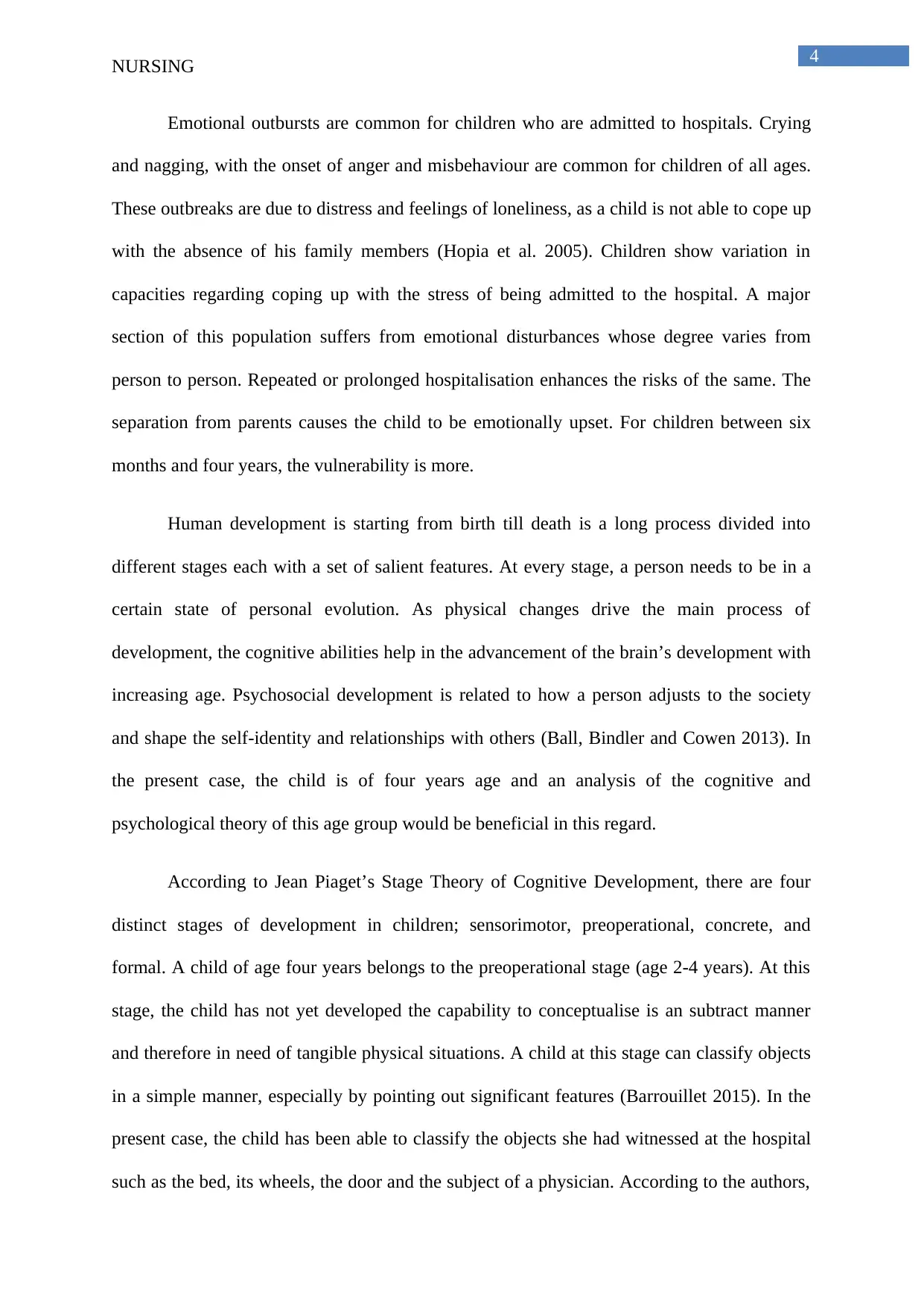
4
NURSING
Emotional outbursts are common for children who are admitted to hospitals. Crying
and nagging, with the onset of anger and misbehaviour are common for children of all ages.
These outbreaks are due to distress and feelings of loneliness, as a child is not able to cope up
with the absence of his family members (Hopia et al. 2005). Children show variation in
capacities regarding coping up with the stress of being admitted to the hospital. A major
section of this population suffers from emotional disturbances whose degree varies from
person to person. Repeated or prolonged hospitalisation enhances the risks of the same. The
separation from parents causes the child to be emotionally upset. For children between six
months and four years, the vulnerability is more.
Human development is starting from birth till death is a long process divided into
different stages each with a set of salient features. At every stage, a person needs to be in a
certain state of personal evolution. As physical changes drive the main process of
development, the cognitive abilities help in the advancement of the brain’s development with
increasing age. Psychosocial development is related to how a person adjusts to the society
and shape the self-identity and relationships with others (Ball, Bindler and Cowen 2013). In
the present case, the child is of four years age and an analysis of the cognitive and
psychological theory of this age group would be beneficial in this regard.
According to Jean Piaget’s Stage Theory of Cognitive Development, there are four
distinct stages of development in children; sensorimotor, preoperational, concrete, and
formal. A child of age four years belongs to the preoperational stage (age 2-4 years). At this
stage, the child has not yet developed the capability to conceptualise is an subtract manner
and therefore in need of tangible physical situations. A child at this stage can classify objects
in a simple manner, especially by pointing out significant features (Barrouillet 2015). In the
present case, the child has been able to classify the objects she had witnessed at the hospital
such as the bed, its wheels, the door and the subject of a physician. According to the authors,
NURSING
Emotional outbursts are common for children who are admitted to hospitals. Crying
and nagging, with the onset of anger and misbehaviour are common for children of all ages.
These outbreaks are due to distress and feelings of loneliness, as a child is not able to cope up
with the absence of his family members (Hopia et al. 2005). Children show variation in
capacities regarding coping up with the stress of being admitted to the hospital. A major
section of this population suffers from emotional disturbances whose degree varies from
person to person. Repeated or prolonged hospitalisation enhances the risks of the same. The
separation from parents causes the child to be emotionally upset. For children between six
months and four years, the vulnerability is more.
Human development is starting from birth till death is a long process divided into
different stages each with a set of salient features. At every stage, a person needs to be in a
certain state of personal evolution. As physical changes drive the main process of
development, the cognitive abilities help in the advancement of the brain’s development with
increasing age. Psychosocial development is related to how a person adjusts to the society
and shape the self-identity and relationships with others (Ball, Bindler and Cowen 2013). In
the present case, the child is of four years age and an analysis of the cognitive and
psychological theory of this age group would be beneficial in this regard.
According to Jean Piaget’s Stage Theory of Cognitive Development, there are four
distinct stages of development in children; sensorimotor, preoperational, concrete, and
formal. A child of age four years belongs to the preoperational stage (age 2-4 years). At this
stage, the child has not yet developed the capability to conceptualise is an subtract manner
and therefore in need of tangible physical situations. A child at this stage can classify objects
in a simple manner, especially by pointing out significant features (Barrouillet 2015). In the
present case, the child has been able to classify the objects she had witnessed at the hospital
such as the bed, its wheels, the door and the subject of a physician. According to the authors,
Secure Best Marks with AI Grader
Need help grading? Try our AI Grader for instant feedback on your assignments.
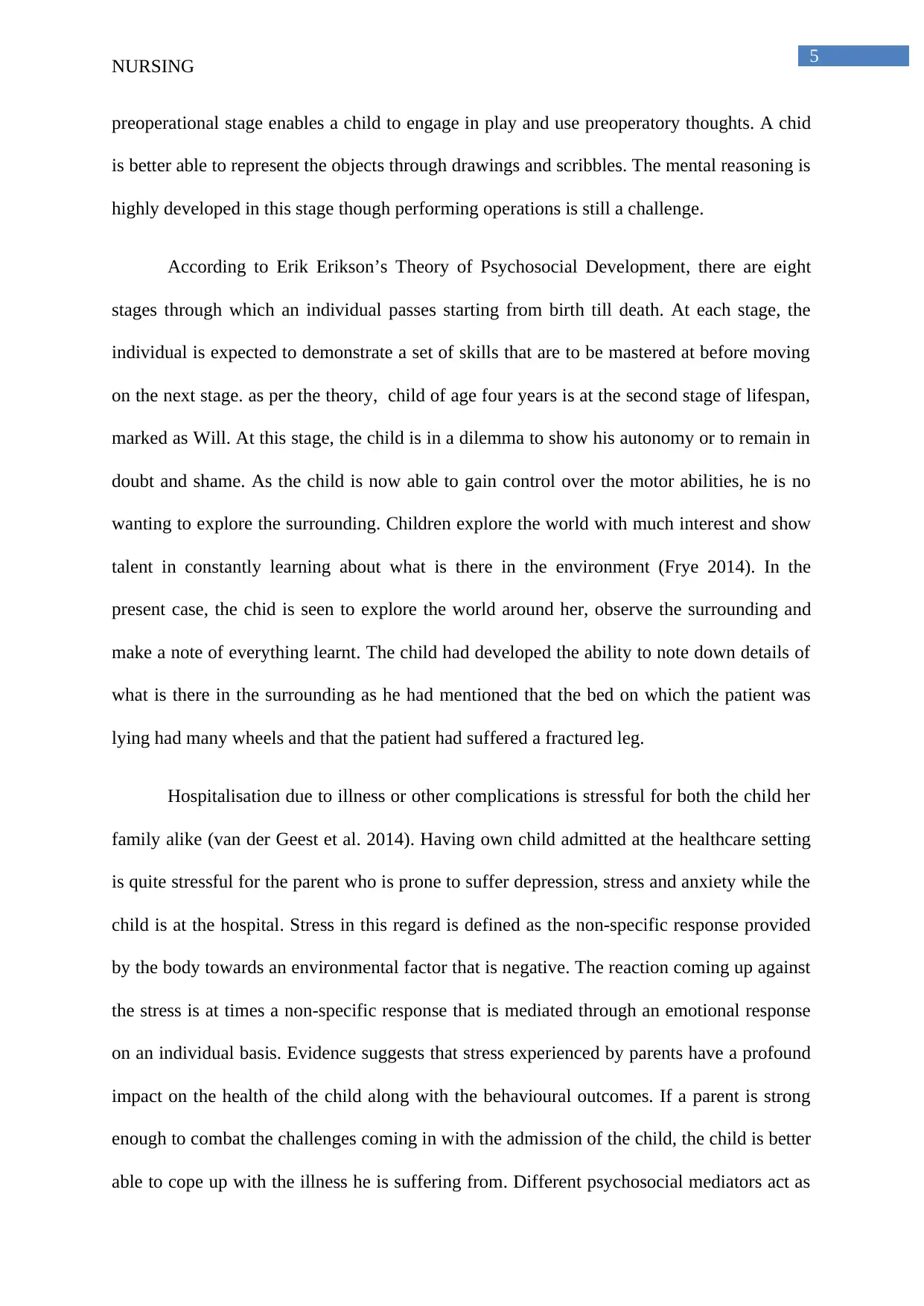
5
NURSING
preoperational stage enables a child to engage in play and use preoperatory thoughts. A chid
is better able to represent the objects through drawings and scribbles. The mental reasoning is
highly developed in this stage though performing operations is still a challenge.
According to Erik Erikson’s Theory of Psychosocial Development, there are eight
stages through which an individual passes starting from birth till death. At each stage, the
individual is expected to demonstrate a set of skills that are to be mastered at before moving
on the next stage. as per the theory, child of age four years is at the second stage of lifespan,
marked as Will. At this stage, the child is in a dilemma to show his autonomy or to remain in
doubt and shame. As the child is now able to gain control over the motor abilities, he is no
wanting to explore the surrounding. Children explore the world with much interest and show
talent in constantly learning about what is there in the environment (Frye 2014). In the
present case, the chid is seen to explore the world around her, observe the surrounding and
make a note of everything learnt. The child had developed the ability to note down details of
what is there in the surrounding as he had mentioned that the bed on which the patient was
lying had many wheels and that the patient had suffered a fractured leg.
Hospitalisation due to illness or other complications is stressful for both the child her
family alike (van der Geest et al. 2014). Having own child admitted at the healthcare setting
is quite stressful for the parent who is prone to suffer depression, stress and anxiety while the
child is at the hospital. Stress in this regard is defined as the non-specific response provided
by the body towards an environmental factor that is negative. The reaction coming up against
the stress is at times a non-specific response that is mediated through an emotional response
on an individual basis. Evidence suggests that stress experienced by parents have a profound
impact on the health of the child along with the behavioural outcomes. If a parent is strong
enough to combat the challenges coming in with the admission of the child, the child is better
able to cope up with the illness he is suffering from. Different psychosocial mediators act as
NURSING
preoperational stage enables a child to engage in play and use preoperatory thoughts. A chid
is better able to represent the objects through drawings and scribbles. The mental reasoning is
highly developed in this stage though performing operations is still a challenge.
According to Erik Erikson’s Theory of Psychosocial Development, there are eight
stages through which an individual passes starting from birth till death. At each stage, the
individual is expected to demonstrate a set of skills that are to be mastered at before moving
on the next stage. as per the theory, child of age four years is at the second stage of lifespan,
marked as Will. At this stage, the child is in a dilemma to show his autonomy or to remain in
doubt and shame. As the child is now able to gain control over the motor abilities, he is no
wanting to explore the surrounding. Children explore the world with much interest and show
talent in constantly learning about what is there in the environment (Frye 2014). In the
present case, the chid is seen to explore the world around her, observe the surrounding and
make a note of everything learnt. The child had developed the ability to note down details of
what is there in the surrounding as he had mentioned that the bed on which the patient was
lying had many wheels and that the patient had suffered a fractured leg.
Hospitalisation due to illness or other complications is stressful for both the child her
family alike (van der Geest et al. 2014). Having own child admitted at the healthcare setting
is quite stressful for the parent who is prone to suffer depression, stress and anxiety while the
child is at the hospital. Stress in this regard is defined as the non-specific response provided
by the body towards an environmental factor that is negative. The reaction coming up against
the stress is at times a non-specific response that is mediated through an emotional response
on an individual basis. Evidence suggests that stress experienced by parents have a profound
impact on the health of the child along with the behavioural outcomes. If a parent is strong
enough to combat the challenges coming in with the admission of the child, the child is better
able to cope up with the illness he is suffering from. Different psychosocial mediators act as
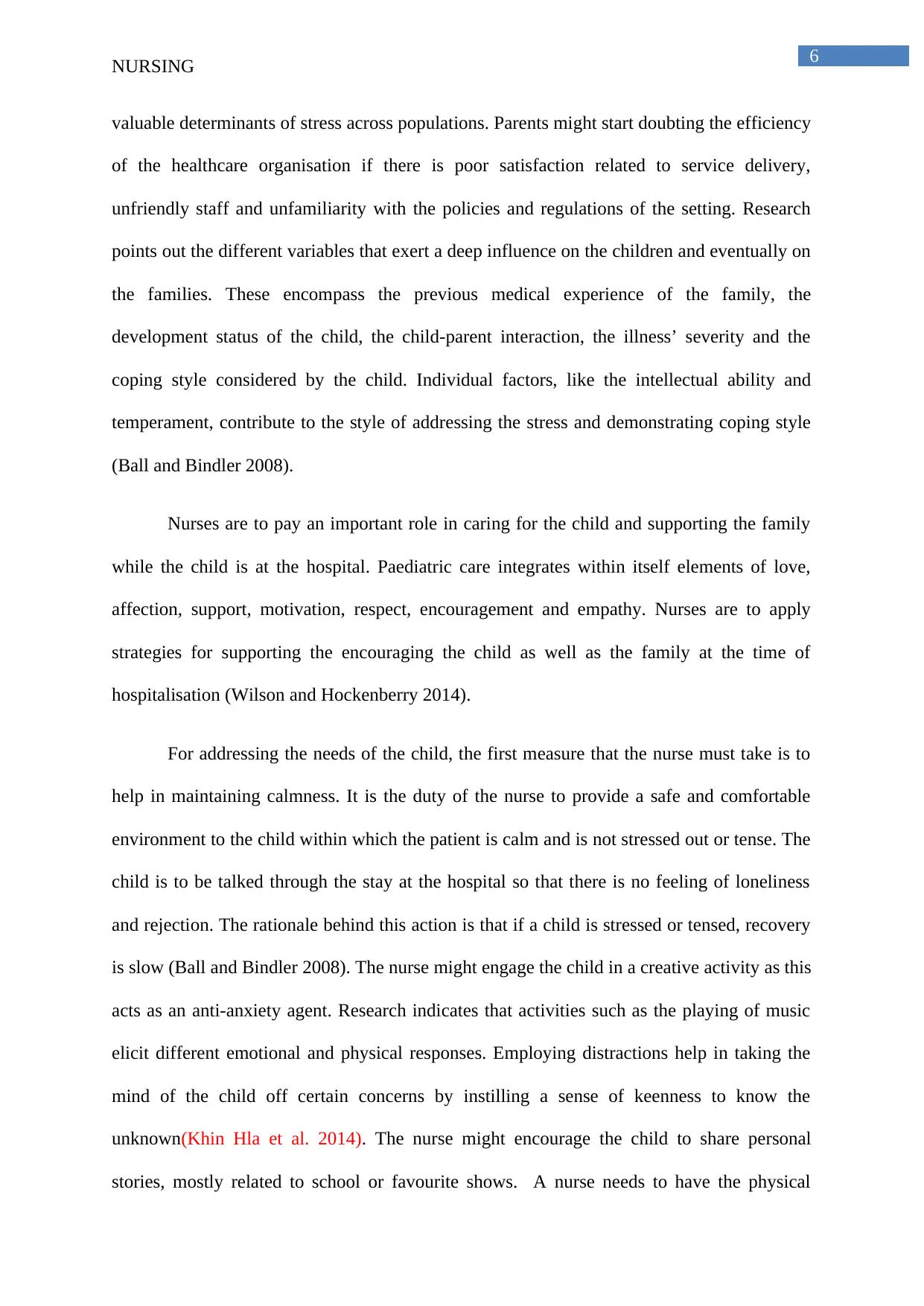
6
NURSING
valuable determinants of stress across populations. Parents might start doubting the efficiency
of the healthcare organisation if there is poor satisfaction related to service delivery,
unfriendly staff and unfamiliarity with the policies and regulations of the setting. Research
points out the different variables that exert a deep influence on the children and eventually on
the families. These encompass the previous medical experience of the family, the
development status of the child, the child-parent interaction, the illness’ severity and the
coping style considered by the child. Individual factors, like the intellectual ability and
temperament, contribute to the style of addressing the stress and demonstrating coping style
(Ball and Bindler 2008).
Nurses are to pay an important role in caring for the child and supporting the family
while the child is at the hospital. Paediatric care integrates within itself elements of love,
affection, support, motivation, respect, encouragement and empathy. Nurses are to apply
strategies for supporting the encouraging the child as well as the family at the time of
hospitalisation (Wilson and Hockenberry 2014).
For addressing the needs of the child, the first measure that the nurse must take is to
help in maintaining calmness. It is the duty of the nurse to provide a safe and comfortable
environment to the child within which the patient is calm and is not stressed out or tense. The
child is to be talked through the stay at the hospital so that there is no feeling of loneliness
and rejection. The rationale behind this action is that if a child is stressed or tensed, recovery
is slow (Ball and Bindler 2008). The nurse might engage the child in a creative activity as this
acts as an anti-anxiety agent. Research indicates that activities such as the playing of music
elicit different emotional and physical responses. Employing distractions help in taking the
mind of the child off certain concerns by instilling a sense of keenness to know the
unknown(Khin Hla et al. 2014). The nurse might encourage the child to share personal
stories, mostly related to school or favourite shows. A nurse needs to have the physical
NURSING
valuable determinants of stress across populations. Parents might start doubting the efficiency
of the healthcare organisation if there is poor satisfaction related to service delivery,
unfriendly staff and unfamiliarity with the policies and regulations of the setting. Research
points out the different variables that exert a deep influence on the children and eventually on
the families. These encompass the previous medical experience of the family, the
development status of the child, the child-parent interaction, the illness’ severity and the
coping style considered by the child. Individual factors, like the intellectual ability and
temperament, contribute to the style of addressing the stress and demonstrating coping style
(Ball and Bindler 2008).
Nurses are to pay an important role in caring for the child and supporting the family
while the child is at the hospital. Paediatric care integrates within itself elements of love,
affection, support, motivation, respect, encouragement and empathy. Nurses are to apply
strategies for supporting the encouraging the child as well as the family at the time of
hospitalisation (Wilson and Hockenberry 2014).
For addressing the needs of the child, the first measure that the nurse must take is to
help in maintaining calmness. It is the duty of the nurse to provide a safe and comfortable
environment to the child within which the patient is calm and is not stressed out or tense. The
child is to be talked through the stay at the hospital so that there is no feeling of loneliness
and rejection. The rationale behind this action is that if a child is stressed or tensed, recovery
is slow (Ball and Bindler 2008). The nurse might engage the child in a creative activity as this
acts as an anti-anxiety agent. Research indicates that activities such as the playing of music
elicit different emotional and physical responses. Employing distractions help in taking the
mind of the child off certain concerns by instilling a sense of keenness to know the
unknown(Khin Hla et al. 2014). The nurse might encourage the child to share personal
stories, mostly related to school or favourite shows. A nurse needs to have the physical
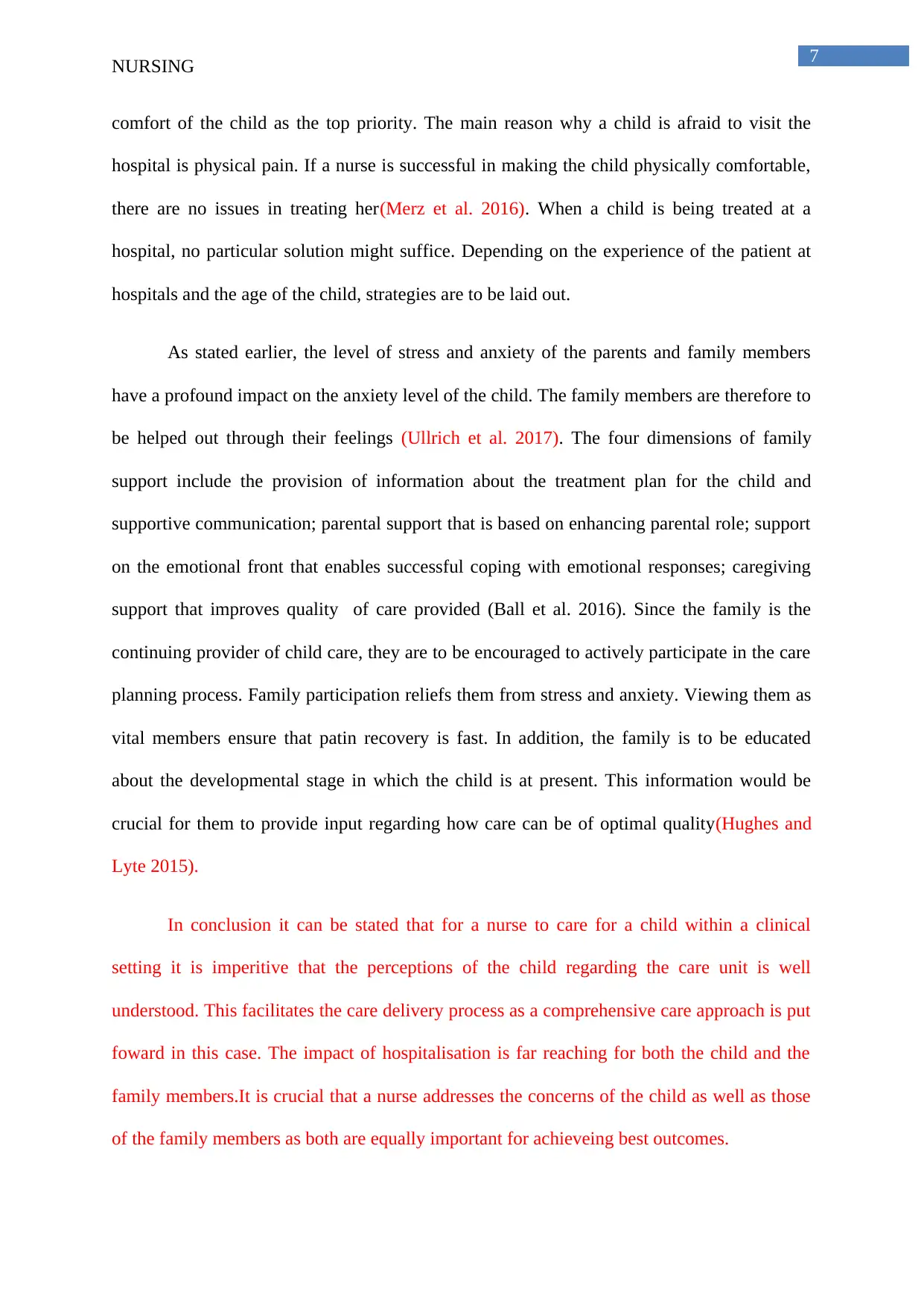
7
NURSING
comfort of the child as the top priority. The main reason why a child is afraid to visit the
hospital is physical pain. If a nurse is successful in making the child physically comfortable,
there are no issues in treating her(Merz et al. 2016). When a child is being treated at a
hospital, no particular solution might suffice. Depending on the experience of the patient at
hospitals and the age of the child, strategies are to be laid out.
As stated earlier, the level of stress and anxiety of the parents and family members
have a profound impact on the anxiety level of the child. The family members are therefore to
be helped out through their feelings (Ullrich et al. 2017). The four dimensions of family
support include the provision of information about the treatment plan for the child and
supportive communication; parental support that is based on enhancing parental role; support
on the emotional front that enables successful coping with emotional responses; caregiving
support that improves quality of care provided (Ball et al. 2016). Since the family is the
continuing provider of child care, they are to be encouraged to actively participate in the care
planning process. Family participation reliefs them from stress and anxiety. Viewing them as
vital members ensure that patin recovery is fast. In addition, the family is to be educated
about the developmental stage in which the child is at present. This information would be
crucial for them to provide input regarding how care can be of optimal quality(Hughes and
Lyte 2015).
In conclusion it can be stated that for a nurse to care for a child within a clinical
setting it is imperitive that the perceptions of the child regarding the care unit is well
understood. This facilitates the care delivery process as a comprehensive care approach is put
foward in this case. The impact of hospitalisation is far reaching for both the child and the
family members.It is crucial that a nurse addresses the concerns of the child as well as those
of the family members as both are equally important for achieveing best outcomes.
NURSING
comfort of the child as the top priority. The main reason why a child is afraid to visit the
hospital is physical pain. If a nurse is successful in making the child physically comfortable,
there are no issues in treating her(Merz et al. 2016). When a child is being treated at a
hospital, no particular solution might suffice. Depending on the experience of the patient at
hospitals and the age of the child, strategies are to be laid out.
As stated earlier, the level of stress and anxiety of the parents and family members
have a profound impact on the anxiety level of the child. The family members are therefore to
be helped out through their feelings (Ullrich et al. 2017). The four dimensions of family
support include the provision of information about the treatment plan for the child and
supportive communication; parental support that is based on enhancing parental role; support
on the emotional front that enables successful coping with emotional responses; caregiving
support that improves quality of care provided (Ball et al. 2016). Since the family is the
continuing provider of child care, they are to be encouraged to actively participate in the care
planning process. Family participation reliefs them from stress and anxiety. Viewing them as
vital members ensure that patin recovery is fast. In addition, the family is to be educated
about the developmental stage in which the child is at present. This information would be
crucial for them to provide input regarding how care can be of optimal quality(Hughes and
Lyte 2015).
In conclusion it can be stated that for a nurse to care for a child within a clinical
setting it is imperitive that the perceptions of the child regarding the care unit is well
understood. This facilitates the care delivery process as a comprehensive care approach is put
foward in this case. The impact of hospitalisation is far reaching for both the child and the
family members.It is crucial that a nurse addresses the concerns of the child as well as those
of the family members as both are equally important for achieveing best outcomes.
Paraphrase This Document
Need a fresh take? Get an instant paraphrase of this document with our AI Paraphraser
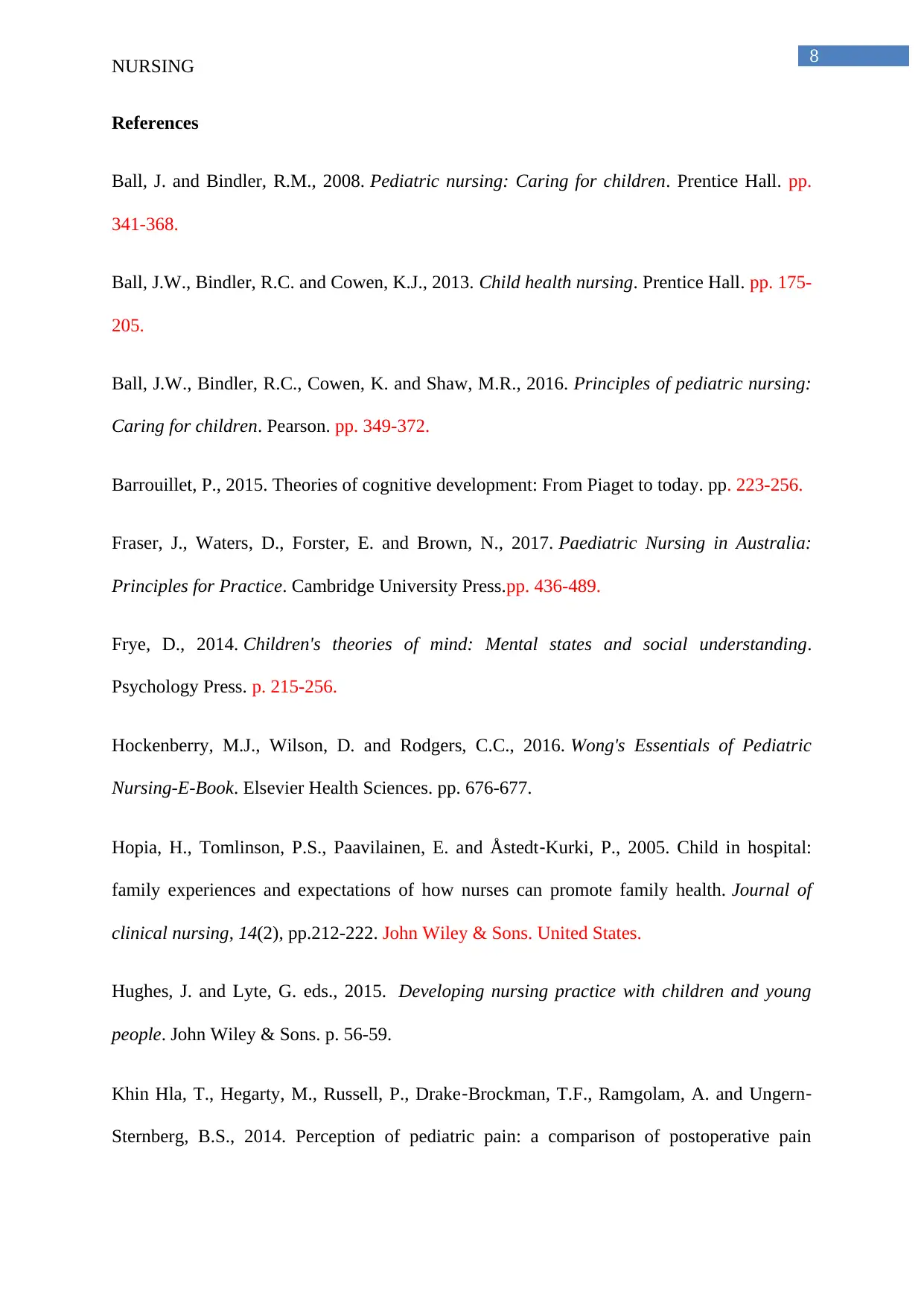
8
NURSING
References
Ball, J. and Bindler, R.M., 2008. Pediatric nursing: Caring for children. Prentice Hall. pp.
341-368.
Ball, J.W., Bindler, R.C. and Cowen, K.J., 2013. Child health nursing. Prentice Hall. pp. 175-
205.
Ball, J.W., Bindler, R.C., Cowen, K. and Shaw, M.R., 2016. Principles of pediatric nursing:
Caring for children. Pearson. pp. 349-372.
Barrouillet, P., 2015. Theories of cognitive development: From Piaget to today. pp. 223-256.
Fraser, J., Waters, D., Forster, E. and Brown, N., 2017. Paediatric Nursing in Australia:
Principles for Practice. Cambridge University Press.pp. 436-489.
Frye, D., 2014. Children's theories of mind: Mental states and social understanding.
Psychology Press. p. 215-256.
Hockenberry, M.J., Wilson, D. and Rodgers, C.C., 2016. Wong's Essentials of Pediatric
Nursing-E-Book. Elsevier Health Sciences. pp. 676-677.
Hopia, H., Tomlinson, P.S., Paavilainen, E. and Åstedt‐Kurki, P., 2005. Child in hospital:
family experiences and expectations of how nurses can promote family health. Journal of
clinical nursing, 14(2), pp.212-222. John Wiley & Sons. United States.
Hughes, J. and Lyte, G. eds., 2015. Developing nursing practice with children and young
people. John Wiley & Sons. p. 56-59.
Khin Hla, T., Hegarty, M., Russell, P., Drake‐Brockman, T.F., Ramgolam, A. and Ungern‐
Sternberg, B.S., 2014. Perception of pediatric pain: a comparison of postoperative pain
NURSING
References
Ball, J. and Bindler, R.M., 2008. Pediatric nursing: Caring for children. Prentice Hall. pp.
341-368.
Ball, J.W., Bindler, R.C. and Cowen, K.J., 2013. Child health nursing. Prentice Hall. pp. 175-
205.
Ball, J.W., Bindler, R.C., Cowen, K. and Shaw, M.R., 2016. Principles of pediatric nursing:
Caring for children. Pearson. pp. 349-372.
Barrouillet, P., 2015. Theories of cognitive development: From Piaget to today. pp. 223-256.
Fraser, J., Waters, D., Forster, E. and Brown, N., 2017. Paediatric Nursing in Australia:
Principles for Practice. Cambridge University Press.pp. 436-489.
Frye, D., 2014. Children's theories of mind: Mental states and social understanding.
Psychology Press. p. 215-256.
Hockenberry, M.J., Wilson, D. and Rodgers, C.C., 2016. Wong's Essentials of Pediatric
Nursing-E-Book. Elsevier Health Sciences. pp. 676-677.
Hopia, H., Tomlinson, P.S., Paavilainen, E. and Åstedt‐Kurki, P., 2005. Child in hospital:
family experiences and expectations of how nurses can promote family health. Journal of
clinical nursing, 14(2), pp.212-222. John Wiley & Sons. United States.
Hughes, J. and Lyte, G. eds., 2015. Developing nursing practice with children and young
people. John Wiley & Sons. p. 56-59.
Khin Hla, T., Hegarty, M., Russell, P., Drake‐Brockman, T.F., Ramgolam, A. and Ungern‐
Sternberg, B.S., 2014. Perception of pediatric pain: a comparison of postoperative pain
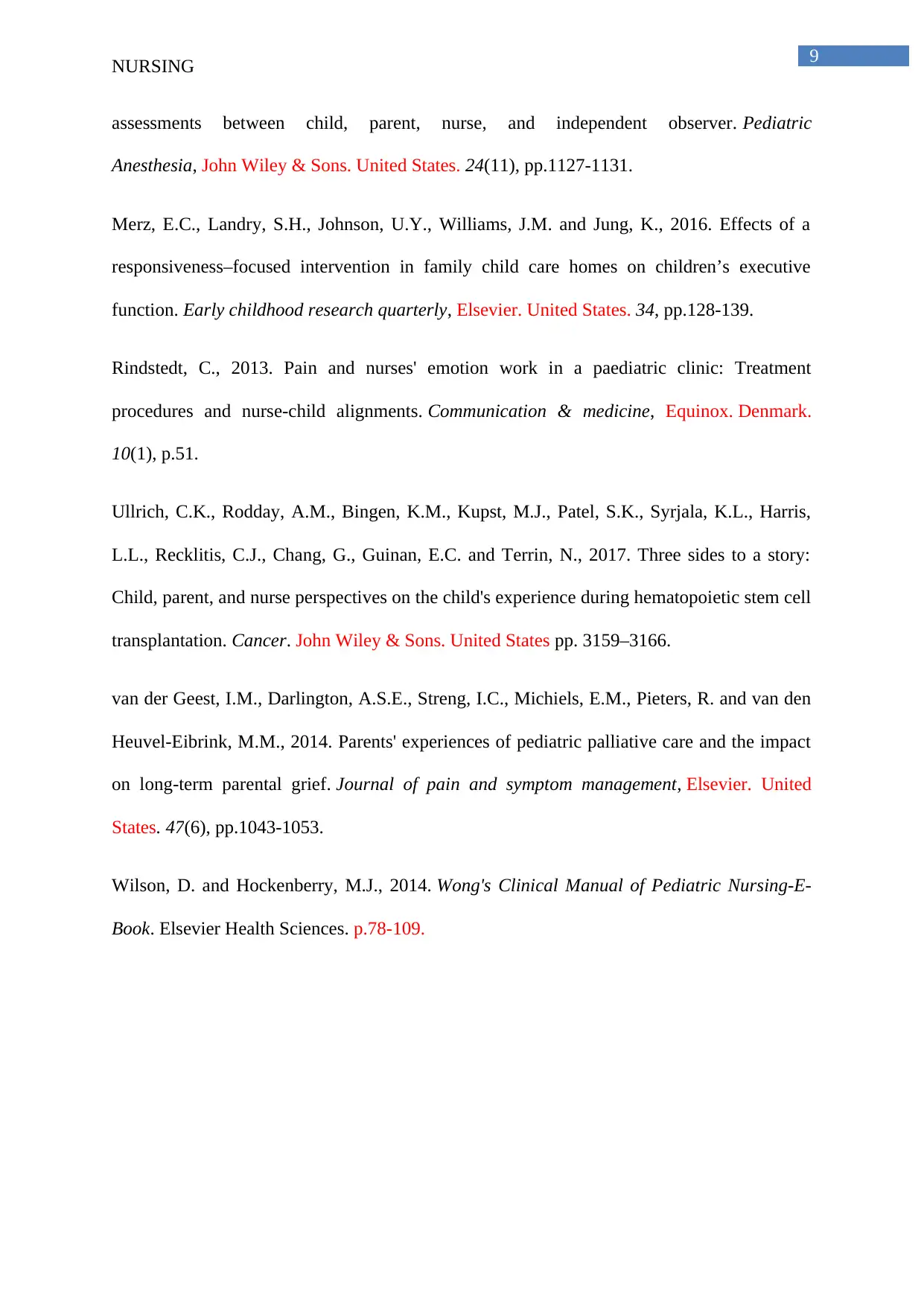
9
NURSING
assessments between child, parent, nurse, and independent observer. Pediatric
Anesthesia, John Wiley & Sons. United States. 24(11), pp.1127-1131.
Merz, E.C., Landry, S.H., Johnson, U.Y., Williams, J.M. and Jung, K., 2016. Effects of a
responsiveness–focused intervention in family child care homes on children’s executive
function. Early childhood research quarterly, Elsevier. United States. 34, pp.128-139.
Rindstedt, C., 2013. Pain and nurses' emotion work in a paediatric clinic: Treatment
procedures and nurse-child alignments. Communication & medicine, Equinox. Denmark.
10(1), p.51.
Ullrich, C.K., Rodday, A.M., Bingen, K.M., Kupst, M.J., Patel, S.K., Syrjala, K.L., Harris,
L.L., Recklitis, C.J., Chang, G., Guinan, E.C. and Terrin, N., 2017. Three sides to a story:
Child, parent, and nurse perspectives on the child's experience during hematopoietic stem cell
transplantation. Cancer. John Wiley & Sons. United States pp. 3159–3166.
van der Geest, I.M., Darlington, A.S.E., Streng, I.C., Michiels, E.M., Pieters, R. and van den
Heuvel-Eibrink, M.M., 2014. Parents' experiences of pediatric palliative care and the impact
on long-term parental grief. Journal of pain and symptom management, Elsevier. United
States. 47(6), pp.1043-1053.
Wilson, D. and Hockenberry, M.J., 2014. Wong's Clinical Manual of Pediatric Nursing-E-
Book. Elsevier Health Sciences. p.78-109.
NURSING
assessments between child, parent, nurse, and independent observer. Pediatric
Anesthesia, John Wiley & Sons. United States. 24(11), pp.1127-1131.
Merz, E.C., Landry, S.H., Johnson, U.Y., Williams, J.M. and Jung, K., 2016. Effects of a
responsiveness–focused intervention in family child care homes on children’s executive
function. Early childhood research quarterly, Elsevier. United States. 34, pp.128-139.
Rindstedt, C., 2013. Pain and nurses' emotion work in a paediatric clinic: Treatment
procedures and nurse-child alignments. Communication & medicine, Equinox. Denmark.
10(1), p.51.
Ullrich, C.K., Rodday, A.M., Bingen, K.M., Kupst, M.J., Patel, S.K., Syrjala, K.L., Harris,
L.L., Recklitis, C.J., Chang, G., Guinan, E.C. and Terrin, N., 2017. Three sides to a story:
Child, parent, and nurse perspectives on the child's experience during hematopoietic stem cell
transplantation. Cancer. John Wiley & Sons. United States pp. 3159–3166.
van der Geest, I.M., Darlington, A.S.E., Streng, I.C., Michiels, E.M., Pieters, R. and van den
Heuvel-Eibrink, M.M., 2014. Parents' experiences of pediatric palliative care and the impact
on long-term parental grief. Journal of pain and symptom management, Elsevier. United
States. 47(6), pp.1043-1053.
Wilson, D. and Hockenberry, M.J., 2014. Wong's Clinical Manual of Pediatric Nursing-E-
Book. Elsevier Health Sciences. p.78-109.
1 out of 9
Related Documents
Your All-in-One AI-Powered Toolkit for Academic Success.
+13062052269
info@desklib.com
Available 24*7 on WhatsApp / Email
![[object Object]](/_next/static/media/star-bottom.7253800d.svg)
Unlock your academic potential
© 2024 | Zucol Services PVT LTD | All rights reserved.





